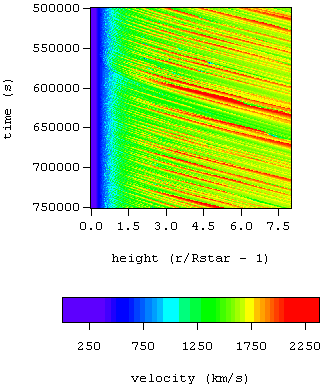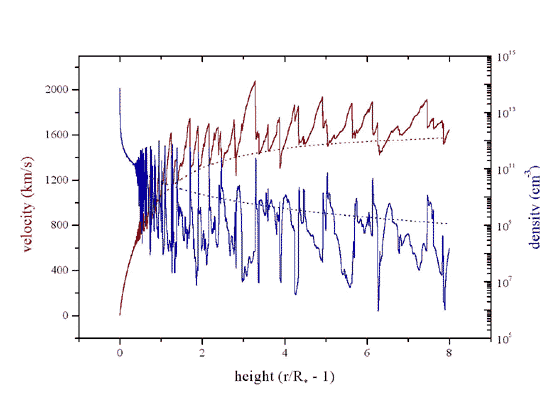I have become quite interested in the small-scale, irregular variability that seems to be
caused by the line-force instability. My interest in this is driven by a desire to understand
the X-ray emission that is ubiquitous in O and B stars. As mentioned above, hot stars are not
supposed to have magnetic fields and associated magnetic dynamos and hot coronae like the sun
does.
There has emerged a consensus over the past decade or two that the origin of X-rays in hot stars lies in the nature of line-driving itself (although there has been very little quantitative confirmation of this picture).
We've seen how the Doppler shift and the associated desaturation of optically thick lines is crucial to the existence of line-driven winds. But this line-driving mechanism has an inherent instability. A positive (negative) velocity perturbation moves a parcel of wind material farther out of (into) the absorption shadow of the material behind it. This causes an additional acceleration (deceleration) which moves the parcel farther out of (into) the shadow. This runaway process is highly unstable, with perturbations being amplified by hundreds of e-folds (see Owocki, Castor, and Rybicki's original analytic explorations of the instability).
The line-force instability thus imparts a huge amount of structure to any line-driven wind, with fast parcel being rapidly accelerated and slow parcels coasting and accreting material to form dense clumps. The result is a highly non-monotonic outflow with strong shocks as the fast wind streams collide with the slower moving clumps. These strong shocks lead to heating of some of the wind material, perhaps to X-ray-emitting temperatures (basically half-a-million degrees K and above).
I have been working with Stan Owocki to numerically calculate the structure, including shocks, in hot star winds using a radiation-hydrodynamics code. Here are some of our simulation results.

|
The output from a time-dependent, spherically symmetric numerical simulation of the wind of zeta Pup, nd O supergiant. The velocity as both a function of time and height above the star is shown. It can be seen that the wind structure begins about 0.5 to 1 stellar radius into the flow. Fast streams are continuously being accelerated, sweeping up material, and merging; with the occasional sudden deceleration in a reverse shock. The 1-D (sperically symmetric) nature of the simulation is necessitated by the great computational expense in calculating the radiation transport non-locally. The radiation field is not only non-local, but has a scattering component that includes photons from the downstream flow. |

|
A time snapshot from the simulation shown above, this time also including the density. The corresponding steady-state solutions are indicated by dotted lines. Several strong shock fronts can be seen in this typical snapshot. But note that the material flowing into the shock fronts is fast and rarefied. There are very few places in these simulations where overdense material is shock heated to X-ray emitting temperatures. |
All of this instability-driven complex structure in the chaotic wind arises naturally from the instability. It does not need to be artificially seeded with any type of initial perturbation, nor are there any explicitly time-variable boundary conditions. The structure is self-excited. In my opinion, this theoretical consideration (coupled with a lack of a good alternative mechanism) is the primary reason for the general acceptance of the line-force instability as the X-ray production mechanism in hot stars.
However, the physical nature of the shock structure (reverse shocks with rarefied inflow) leads
to a wind that, at any given time, has only a small fraction (< 1%) of its mass at X-ray temperatures.
Furthermore, it is very difficult to accurately calculate the evolution of shock-heated gas
in a numerical hydrodynamical calculation. There are computational problems (due, for example, to the
need to average on the discrete computational grid very narrow hot regions that
are just forming with cooler gas nearby) and physical problems (due primarily to the fact that hotter
gas cools less efficiently than less hot gas) that force one to use indirect means
to estimate the X-ray emission from a time-dependent shocked wind. Many of these computational
issues have been discussed by Achim Feldmeier.
All these modeling results have to be measured against data. And it is X-ray spectroscopy that provides the most direct insight into the temperature, density, velocity, and spatial structure of the hot wind. We have already come to some broad conclusions about hot star winds and X-ray emission based on the low-resolution data that's been available for the past two decades: (1) The hot gas is distributed throughout the stellar wind in a way that is broadly consistent with the line-force instability models (at least in one early B bright giant, epsilon CMa); (2) The X-rays and EUV emission have a strong influence on the ionization balance, and thus the UV line strengths, in hot star winds. This is especially true of the thinner winds of B stars; (3) The amount of X-rays that the numerical simulations produce is broadly consistent with the low-resolution X-ray spectra of the hotter O stars, but for the less hot B stars, the observed X-rays imply either very large X-ray filling factors or very high density shock zones, or both; (4) The Observed X-ray properties of hot stars are controlled as much, if not more, by wind absorption than by the intrinsic X-ray production; (5) There must be many, many individual shock zones to explain the observed lack of X-ray time variability in hot stars; and (6) At least some unusual stars, like tau Sco, show X-rays from gas that is so hot it is difficult to understand unless the wind shocks are not due to the line-force instability alone.
Soon, we'll have hugely improved X-ray data to constrain some of these models. The launch of Chandra
and XMM have provided, for the first time, high-resolution X-ray spectra. We will soon be
getting spectra of tau Sco (Chandra) and epsilon CMa (XMM) that will allow us to look at
individual line profiles and measure density- and
temperature-sensitive line ratios.
Hot Star Wind Information:
For a basic review, check out Stan Owocki's excellent encyclopedia article on hot star winds. Click here for a PDF version of the article.
You can buy Henny Lamers and Joe Cassinelli's book on stellar winds from your favorite on-line bookstore or from one with a better price.
You might also want to look at some other webpages written on this subject by my colleagues: Steve Cranmer, Ken Gayley, Karen & Jon Bjorkman et al. at U. Toledo, Joachim Puls .